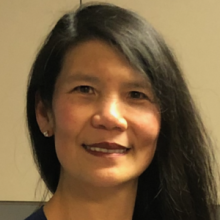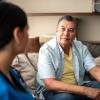
DNP Projects That Transformed Clinical Care
While working as a nurse anesthetist at an endo-surgery clinic, Janice Cain, DNP ’23, CRNA, noticed many patients used marijuana for stress reduction on the day of their procedure.
“The clinic frequently cancelled patients’ surgeries last-minute, citing their marijuana use,” says Cain.
When a patient who had used marijuana was approved for surgery, they were often sent to the emergency room for observation following the procedure. This decision was based on a lack of knowledge about marijuana’s interaction with anesthesia, explains Cain. The result was a strain on the emergency room’s already limited resources.
How Does Marijuana Impact Anesthesia?
Cain was a Doctor of Nursing Practice (DNP) student at the UCSF School of Nursing during this time, enrolled in the Post-Master’s pathway. A requirement of the program is for students to design and present a quality improvement project on a health care practice issue.

For her project, Cain chose to educate certified registered nurse anesthetists (CRNAs) about the effects of marijuana use and its implications for surgery and anesthesia. There are ways to safely administer anesthesia if pure marijuana – without additives – has been used, she explains.
She created a video tutorial covering topics related to marijuana history, use, legal status and side effects, as well as marijuana’s interaction with the endocannabinoid system and anesthesia.
CRNAs at Cain’s clinic watched the tutorial, and through pre- and post-viewing surveys, Cain analyzed the impact of the video on their learning. Results showed a 25% increase in participants’ confidence in treating patients who had used marijuana and a 25-65% increase in their perceived knowledge of marijuana use and anesthesia.
Further, throughout the project’s implementation, the clinic had no procedure cancellations due solely to marijuana use. They also changed their post-operative protocols, keeping patients who had used marijuana in the clinic for observation instead of using the emergency room.
Cain’s educational materials also included non-judgmental communication strategies for talking to patients about marijuana and reasons for abstaining on the day of surgery.
With the growing prevalence of marijuana use in the United States, particularly among diverse and vulnerable populations, Cain says this work is critical. “To advance equity and inclusion in health care, we must educate our patients and health care colleagues about marijuana.”
Diagnosing Morgellons Disease, a Poorly Understood Dermatologic Condition
Melissa Fesler, DNP ’23, RN, FNP-BC, works in a clinic specializing in the diagnosis and treatment of tickborne disease. She frequently encounters patients with Morgellons disease – a poorly understood dermatologic condition associated with spirochetal infection. Symptoms include skin rashes and sores, crawling sensations on or under the skin, and the sense of fibers or threads in or on the skin.
Although there are at least 28,000 new cases of Morgellons disease in the U.S. annually, it is often misdiagnosed.
“It’s common for my patients to have seen at least 10 specialists and still not have a diagnosis or treatment plan,” explains Fesler. Patients are often told incorrectly that their symptoms are from a psychiatric condition.
A lack of evidence-based diagnostic protocols, clinician knowledge and literature contribute to the high rate of misdiagnosis. Fesler is committed to changing that.

While studying in the Post-Master’s pathway of UCSF’s DNP program, she designed a scholarly project to improve the perceived knowledge and confidence of clinicians in diagnosing Morgellons disease. She also developed the disease’s first evidence-based preliminary diagnostic protocol and evaluated its usefulness.
Participants’ average knowledge of Morgellons disease increased 15-19% and their confidence in diagnosing the disease increased 20-25%. All of the participants reported that the protocol was useful.
Most participants were doctors and specialists in tickborne disease, making the increase in these variables even more significant.
Fesler is now disseminating her findings and plans to conduct a systematic review to establish Morgellons disease in the literature, after which she will create clinical practice guidelines.
“I am committed to bringing awareness to this disease and improving the rate of timely and accurate diagnosis,” she says.
Improving Door to Discharge Rate
Managing hospital capacity is a priority for Karen Jennings, DNP ‘23, RN, FNP, director of acute care at UCSF Benioff Children’s Hospital Oakland.
“We need to efficiently discharge patients who are ready to leave the hospital so that we have space to admit new patients,” she explains.
While earning her DNP in the Post-Master’s pathway at UCSF, Jennings designed a quality improvement project to address inefficiencies and delays in moving patients from admission to discharge – commonly referred to as “door to discharge.”

The hospital’s discharge data for 2022 showed access to transportation as the top barrier to efficient discharge. “We consistently found that patients did not have a ride home,” explains Jennings.
The project designed a process for documenting and addressing transportation challenges when the patient is admitted to the hospital, and launched a protocol for establishing an expected discharge date (EDD) and communicating that date to everyone involved in the patients’ care, including their family.
“If the health care team does not know the EDD, how can we expect families to be prepared?” asks Jennings.
The result of Jennings’ project was a 17% increase in establishing an EDD, a 160% increase in documentation of transportation barriers and a 120% increase in establishing a mitigation plan to address transportation challenges.
The project also sought to improve interprofessional collaboration of hospital staff and maintain the hospital’s 25% rate of patient discharge before noon – a common metric for improving hospital capacity management.
After Jennings and her team conducted an interprofessional collaboration training for hospital staff, 92% of participants reported an increase in knowledge. Further, the hospital successfully sustained its 25% rate of discharge before noon throughout the project implementation period.
The project’s implications for nursing practice are clear, says Jennings. “Nurses play a crucial role in discharge planning. We assess patients’ support systems, home environments and access to post-discharge resources, ensuring a safe transition from the hospital to home or another care setting.”



